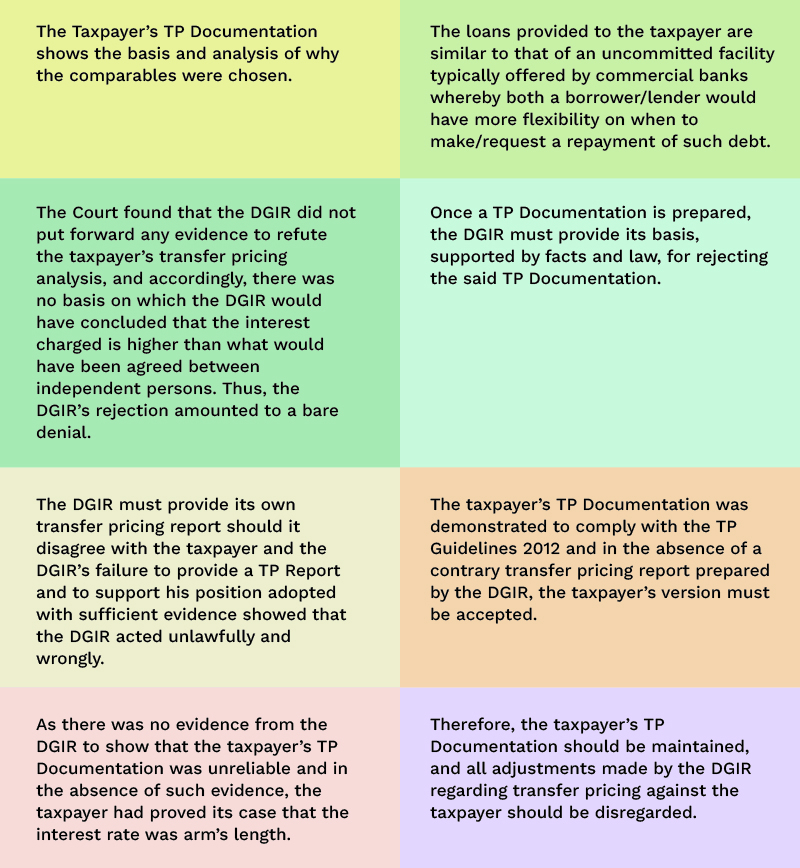By S. Saravana Kumar and Nur Amira Ahmad Azhar
Many multinational enterprises (MNEs) frequently rely on external borrowings to support their operations. MNEs have various borrowing arrangements between the enterprises within the group. As such, the restriction on deductibility of interest under Section 140C of the Income Tax Act 1967 (ITA), Income Tax (Restriction on Deductibility of Interest) Rules 2019 (2019 Rules) and Income Tax (Restriction on Deductibility of Interest) (Amendment) Rules 2022 (2022 Rules) have been introduced to restrict deductions for interest expense or any other payments which are economically equivalent to interest, to ensure that such expenses commensurate with the business income. The 2019 Rules was introduced into the ITA to implement the Earning Stripping Rules (ESR). The Restriction on Deductibility of Interest Guidelines (Restriction Guidelines) was issued to provide clarification on the Rules.
As the legislation is based on Base Erosion and Profit Shifting (BEPS) Action 4 of the Organisation for Economic Cooperation and Development (OECD), the Restriction on Deductibility of Interest Rules (ESR) is intended to prevent base erosion through the use of excessive interest expense or any payment which are economically equivalent to interest via controlled financial assistance.
What is the Arms-Length Interest Deduction?
The Arms-Length Interest Deduction (ALID) is a transfer pricing principle that is used to determine the appropriate level of interest that can be charged between related entities. This principle is based on the concept that transactions between related entities should be conducted on the same terms and conditions as transactions between independent parties (i.e. at arm’s length).
The ALID rule is intended to prevent base erosion through the use of excessive interest expenses or any payments which are economically equivalent to interest. This means that MNEs cannot use their intra-group financing arrangements to reduce their taxable profits by artificially inflating interest expenses.
Implementation of the ALID in Malaysia
The 2019 Rules was gazetted on 28 June 2019 concerning Section 140C of the ITA, which was introduced into the ITA to implement the ESR.
The legislation restricts the interest expenses or payments economically equivalent to interest that can be deducted by specified persons who have been granted financial assistance in a controlled transaction. This means that MNEs must ensure that their intra-group financing arrangements comply with the ALID rule.
To comply with the ALID rule, MNEs must ensure that their financing arrangements are based on commercial terms and conditions. This means that the interest rate and other terms of the loan should be consistent with what would be offered to an independent third party in a similar transaction.
MNEs must also maintain appropriate documentation to support their financing arrangements. This includes records of the terms and conditions of the financing arrangements, the creditworthiness of the borrower, and any other relevant factors that would be considered in a similar transaction between independent parties.
Controlled Transactions
As stated above, the interest restriction only applies to related parties. The definition of “control” under Section 140C(3) of the ITA is defined under Section 140A(5A) of the ITA. It refers to situations where one person owns shares in another person or where a third person owns shares in both persons, and the percentage of share capital held in either situation is 20% or more. Additionally, the business operations of the person receiving financial assistance or engaging in a controlled transaction must depend on proprietary rights provided by the other person or a third person, or their business activities must be specified by the other person, and the prices and conditions relating to the supply must be influenced by such other person or a third person. In some cases, one or more of the directors or members of the board of directors of a person may be appointed by the other person or a third person.
Further, a “controlled transaction” is construed as financial assistance between persons where one person has control over the other, or both persons are controlled by some other person. These provisions aim to prevent tax avoidance and ensure that interest expenses are deductible only in situations where they are genuinely incurred and reflect arm’s length transactions.
Restriction on Interest Expense
The ITA imposes restrictions on the deductibility of interest expenses for certain transactions under Section 140C. Section 140C(3) of the ITA defines interest expense as interest on all forms of debts or payments economically equivalent to interest (excluding expenses incurred in connection with the raising of finance). On the other hand, financial assistance in a controlled transaction is defined under Section 140C(3) of the ITA 1967 to include loans, interest-bearing trade credit, debt, advances, or the provision of any security or guarantee.
According to Section 140C(2) of the ITA, interest expenses incurred in connection with financial assistance or controlled transactions granted directly or indirectly to a person that exceeds the maximum amount of interest as determined under the Act cannot be deducted from the gross income when calculating adjusted income.
Essentially, the ITA restricts the interest expenses or payments economically equivalent to interest that can be deducted by specified persons who have been granted financial assistance in a controlled transaction.
The Earning Stripping Rules Guidelines 2022 (ESR Guidelines) provide a more detailed definition of interest, stating that it is the return or compensation for the use or retention by a person of a sum of money belonging to or owed to another person. The ESR Guidelines also exclude interest expense incurred in connection with the raising of finance (guarantee fee) or not allowable in ascertaining the adjusted income under the ITA before any restriction on the deductibility of interest is made under Section 140C of the ITA of a person from the business source.
The IRB issued a Restriction on Deductibility of Interest Guidelines (Guidelines) to shed light on the applicability of Section 140C of the ITA and the 2019 and 2022 Rules (Legislations). The Guidelines state that the Legislations apply to all persons within the charge to tax under the Act, except certain categories of persons excluded in the 2019 and 2022 Rules.
The Guidelines apply to any person who has interest expense from financial assistance, which is deducted before the restriction on the deduction of interest is made under Section 140C of the ITA. This interest may be accrued, paid, or payable and due to be paid to the person’s associated person outside Malaysia or to a third party outside Malaysia, where the financial assistance is guaranteed by its holding company or any other enterprises under the same MNE Group. This ensures that taxpayers do not artificially shift profits to low-tax jurisdictions by paying excessive interest to related parties.
Furthermore, the guidelines include a de minimis threshold of RM500,000. The interest restriction under Section 140C of the ITA does not apply to a person where the total amount of any interest expense for all financial assistance from all business sources is equal to or less than RM500,000. It is essential to note that the threshold of RM500,000 should be accumulated from all business sources, and the calculation of interest restriction should be made separately on each business source in case a person has multiple business sources.
Another critical aspect of the guidelines is the calculation of Tax-EBITDA (Earnings before Interest, Taxes, Depreciation, and Amortization) to determine the maximum amount of interest deduction that a taxpayer can claim. Negative Tax-EBITDA will be considered as NIL, and any interest payment, which is not due to be paid in a particular year of assessment, would have been excluded in arriving at the adjusted income, part [A] under the tax-EBITDA formula for that year of assessment. However, when the interest is due to be paid, the assessment for that year of assessment will be revised by the taxpayer to allow a deduction of interest under Section 33(5) of the ITA. This provision ensures that interest expenses incurred by taxpayers are appropriately reflected in their tax returns.
Determining Arm’s Length Interest Rate
In determining the arm’s length interest rate and accurately delineating the transaction, the IRB has stated that taxpayers are to refer to the OECD guidelines. The OECD recommends an analysis of the factors affecting the performance of the businesses in the industry sector in which the relevant MNE group operates such as the particular point of an economic, business or product cycle, the effect of government regulations, or the availability of financial resources in a given industry. MNE groups require different amounts and types of financing due to varying capital intensity levels between industries; they also require different levels of short-term cash balances due to differing commercial needs between industries.

Where the relevant MNEs are regulated, i.e. financial services entities subject to regulations consistent with recognised industry standards, the constraints the regulations imposed upon them must be given due consideration. Financial services businesses are required to follow rules prescribing arrangements for risks, and how risks are recognised, measured and disclosed. Thus, the regulatory approach to risk allocation for regulated entities, i.e. the transfer pricing guidance specific to financial services businesses released previously should be considered and referenced where applicable.
Identifying the material risks assumed by each related party in such circumstances is required for a complete functional analysis of such factors. The actual assumption of risk by the parties would influence the prices and other conditions of transactions between the associated enterprises. Within an open market, the assumption of increased risk would be compensated by an increase in the expected returns, even though the actual return is dependent on the actual realisation of risk and may not increase. Risk is inherent where business takes place, and identifying risks goes hand in hand with identifying functions and assets.
In drawing a comparison between controlled and uncontrolled transactions, it is necessary to determine what risks have been assumed to determine the profit potential of the opportunity in the open market and how profits or losses resulting from the transaction are allocated at arm’s length through the pricing of the transaction. The 2022 Guidelines provide a step-by-step approach to accurately delineating the actual transaction concerning that risk.
The process of accurate delineation of the actual transaction also requires an understanding of how the particular MNE group responds to those identified factors. For instance, how the MNE group prioritises the funding needs among different projects, the strategic significance of a particular MNE within the MNE group, whether the MNE group is targeting a specific credit rating or debt-equity ratio and whether the MNE group is adopting a different funding strategy than the one observed in its industry sector.
Accurate delineation of the actual transaction should begin with a thorough identification of the economically relevant characteristics of the transaction – consisting of the commercial/financial relations between the parties and the conditions, economically relevant circumstances attaching to those relations – including an examination of the contractual terms of the transaction, the functions performed, assets used, risks assumed, characteristics of the financial instruments, economic circumstances of the parties and the market, and the business strategies pursued by the parties.
In applying the arm’s length principle to a financial transaction, it is also necessary to consider the conditions that independent parties would have agreed to in comparable or similar circumstances. Independent enterprises, when considering whether to enter into a particular financial transaction, will consider all other realistically available options. They will only enter into the transaction if they see no alternative that offers a more attractive opportunity to meet their commercial objectives. In other words, they will only enter into a transaction if it is not expected to render them worse off than their next available option.
In considering the options realistically available, the perspective of each party to the transaction must be considered. For example, where the entity advances funds, other investment opportunities may be contemplated, considering the specific business objectives of the lender and the context in which a transaction takes place. From the borrower’s perspective, the realistically available options would include broader considerations than the entity’s ability to service its debt, such as the funds it actually needs to meet its operational requirements. In some instances, although an entity may have the capacity to borrow and service an additional amount of debt, it may choose not to do so to avoid placing negative pressure on its credit rating and increasing its cost of capital, and risk jeopardising its access to capital markets and its market reputation.
When seeking to price the accurately delineated actual transaction, the economically relevant characteristics must be considered.
- For example, the contractual arrangements between associated enterprises do not always have a written agreement, and where there is such an agreement, may not be consistent with the actual conduct between the parties. In contrast, where financial transactions occur between independent enterprises the terms and conditions will be explicitly stated in a written agreement and adhered to as such. Thus, in determining whether the transaction is at arm’s length it is necessary to look at the contracts between the parties as well as the actual conduct, and the economic principles that generally govern relationships between independent enterprises in comparable circumstances.
- A functional analysis of the controlled transaction is also necessary. Such an analysis entails identifying the functions performed, the assets used and the risks assumed by the parties. As an example, the lender in an intra-group loan in deciding whether and under which terms to advance funds would evaluate the inherent risks, the capability to commit capital of the business to the investment and the organisation and documentation of the loan. Such a functional analysis would likely include consideration of similar information, such as what a commercial lender or rating agency would consider in determining the creditworthiness of a borrower. A lender in an intra-group loan would not perform their functions at the same intensity as an independent lender. From the perspective of the borrower, functions that would be considered are the definite availability of funds to repay principal and interest on the loan when due, the capacity to provide collateral if needed, and the ability to fulfil any other obligations deriving from the loan contract.
- In the open market, the varying features and attributes of financial instruments affect the pricing of these products and services. In comparison where a controlled transaction occurs, the transaction’s features and attributes similarly play a part in affecting its arm’s length pricing as a financial instrument. An example of such attributes in the case of a loan would be the amount of the loan, its maturity, the schedule of repayment, its nature or purpose, the geographical location of the borrower, collateral provided, the presence and quality of any guarantee and whether the interest rate is fixed or floating.
- In achieving comparability, the markets in which the independent and associated enterprises operate will not have differences that have a material effect on the price, or appropriate adjustments can be made to achieve this effect. Underlying economic circumstances in the open market such as different currency rates, geographic location, local regulations, the timing of the transaction and the business sector of the borrower can affect the price of financial instruments, including loans. Economic factors such as the growth rate, inflation rate and volatility of exchange rates mean that otherwise similar financial instruments issued in different currencies may have different prices. Prices for financial instruments in the same currency may vary across jurisdictions due to local regulations such as interest rate controls, exchange rate controls and foreign exchange restrictions.
Further, macroeconomic trends can also affect prices. These include central bank lending rates, interbank reference rates, and financial market events such as a credit crisis. Therefore, the precise timing of when a financial instrument is issued in the primary market or the selection of comparable data in the secondary market can be significant in terms of comparability. For example, the closer in time a comparable loan issuance is to the issuance of the controlled loan, the less likely that different economic factors will prevail as a factor. Nonetheless, it remains possible for particular events to cause rapid changes in lending markets, reducing comparability between both transactions.

The business strategies of the enterprise must be examined in accurately delineating the actual financial transaction and in determining the comparability of controlled and uncontrolled transactions and enterprises. This is relevant as business strategies affect the terms and conditions of loan agreements between enterprises. Business strategies take into account aspects such as innovation and new product development, degree of diversification, risk aversion, assessment of political changes, the input of existing and planned labour laws, duration of arrangements and other factors bearing upon the daily conduct of business. An examination of business strategies would also entail consideration of the MNE group’s global financing policy, and the identification of existing relationships between the associated enterprises such as pre-existing loans and shareholder interests.
Penalties for non-compliance
Non-compliance with the ALID rule can result in penalties, including disallowance of interest expenses and additional tax assessments. There is no penalty provision specific to Section 140C within the scope of applicable financial transactions. However, where deliberate tax avoidance has been established and the Director General of Inland Revenue (DGIR) elects not to prosecute, Section 113(2) of the ITA allows the DGIR to impose a penalty equal to the amount of tax that has been undercharged in consequence of the incorrect return or incorrect information on the person. Unless the DGIR chooses to exercise his discretion under Section 140(1) of the ITA to vary or disregard the transaction, the extent of the penalty under Section 113(2) of the ITA may reach up to 100% of the tax amount undercharged. Section 140(6) of the ITA expressly includes transfer pricing transactions as transactions subject to the jurisdiction of the DGIR under Section 140(1) of the ITA. MNEs must ensure that they comply with the ALID rule to avoid these penalties.
Importance of TP Documentations
The arm’s length principle is crucial to ensure that intercompany transactions are conducted on a fair and equitable basis. However, disagreements over what constitutes arm’s length pricing can lead to disputes that are difficult to resolve. Therefore, it is crucial for taxpayers who conduct transactions between associated companies to maintain proper transfer pricing documentation. This documentation can help taxpayers demonstrate that their pricing is at arm’s length, avoid disputes with tax authorities, and provide evidence of their compliance with transfer pricing regulations. Furthermore, it can help establish a transparent and consistent pricing policy across different jurisdictions, minimizing the risk of double taxation. Proper transfer pricing documentation is essential to ensure compliance with tax regulations and avoid unnecessary disputes with tax authorities.
Hence, the question of what constitutes arms-length pricing is often contentious and can lead to disputes that are difficult to resolve. The High Court case of Ketua Pengarah Hasil Dalam Negeri v Watsons Personal Care Stores (WA-14-20-06/2020) recently shed light on the importance of transfer pricing documents on both taxpayer and the Inland Revenue Board (IRB).
In this case, Watsons Personal Care Stores (the Taxpayer) borrowed sums of money via loans from Watson Labuan in the years 2003 and 2012 to finance the acquisition of shares in Watson Malaysia. The interest rate on the loans was to be paid at the rate of 3% plus the London Interbank Offered Rate (LIBOR) on a yearly basis, and the principal amount borrowed is to be paid on demand by Watson Labuan. The Director-General of Inland Revenue (DGIR) sought to adjust the interest rate under Section 140A of the Income Tax Act 1967 (ITA) and Rules 8(1)(b) and 8(2) of the Income Tax (Transfer Pricing) Rules 2012 (TP Rules) to 0% and disallow the deduction of interest paid by the taxpayer because the money borrowed was not an arm’s length transaction.
The High Court held that Section 140A ITA does not give the DGIR the power to disregard/ignore any transactions. Instead, Section 140A requires the DGIR to substitute the price in respect of the transaction to reflect an arm’s length price for the transaction where it has reasons to believe the transactions were not carried out at arm’s length. In this regard, the DGIR did not make any adjustments to the structure of the loan transactions or substitute the interest rate for one that would have been expected between independent persons. The DGIR merely substituted the interest rate with 0% on the basis that no independent party would carry out such a transaction. Thus, the DGIR’s failure to make any adjustments to the loans or substitute an arm’s length rate is contrary to section 140A.
In deciding in favour of the taxpayer, the High Court highlighted the importance of a transfer pricing documentation as follows:

Conclusion
MNEs must ensure that their intra-group financing arrangements comply with the ALID rule to avoid penalties and ensure that their tax positions are in line with the legislation. By maintaining appropriate documentation and ensuring that their financing arrangements are based on commercial terms and conditions, MNEs can comply with the ALID rule and avoid any adverse tax consequences.
S. Saravana Kumar is Partner at Rosli Dahlan Saravana Partnership and Nur Amira Ahmad Azhar is Senior Associate at Rosli Dahlan Saravana Partnership.






